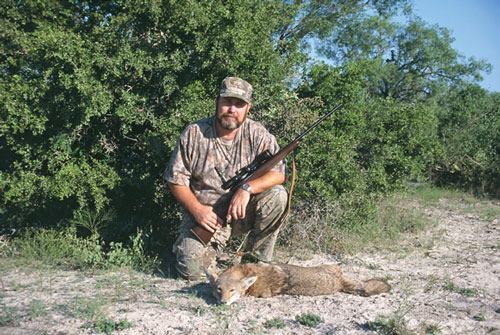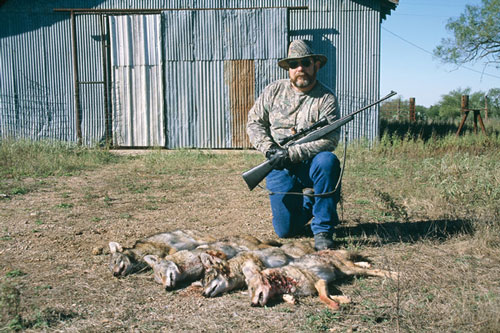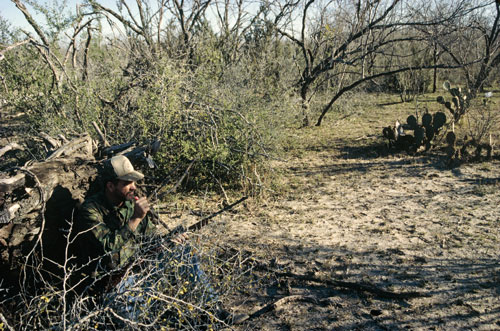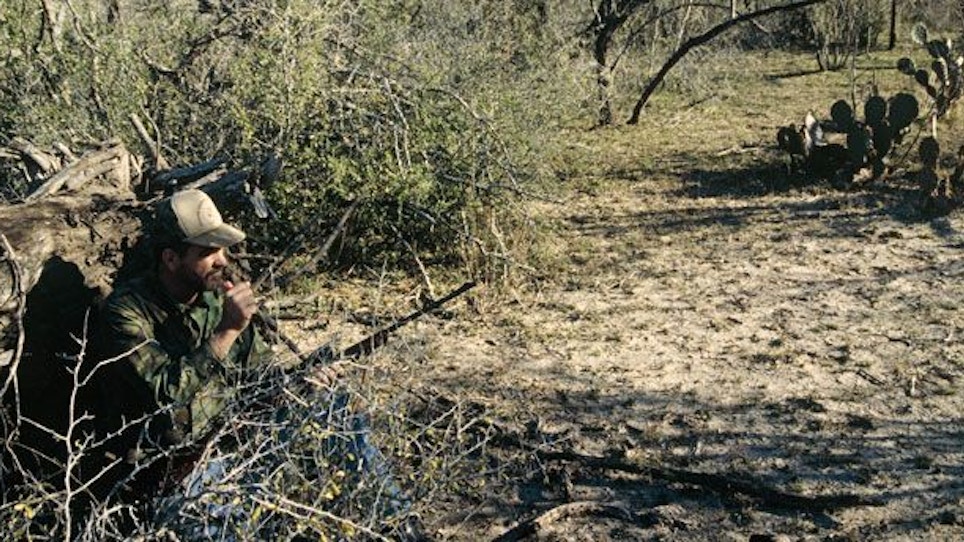 The Brush Country of south Texas is usually hot, dry, and covered with thorny brush thick enough to stall a bulldozer. The predator calling here is often a short-range, fast-action affair, where the shooter has only a second or two to make his shot. It will make a predator hunter into a fast, accurate shot, or turn him into a frustrated, nervous wreck.
The Brush Country of south Texas is usually hot, dry, and covered with thorny brush thick enough to stall a bulldozer. The predator calling here is often a short-range, fast-action affair, where the shooter has only a second or two to make his shot. It will make a predator hunter into a fast, accurate shot, or turn him into a frustrated, nervous wreck.
Brush Country is Shotgun Country
The best shotgun is a 12-gauge chambered for 3-inch shells. The only addition could be a magazine extension, so it holds six rounds. I prefer a modified choke, because it usually patterns buckshot and tungsten loads the best. An improved cylinder doesn’t provide enough range. Stay away from 00 buckshot and stick to the smaller buckshot like B, BB, and #4 that give denser patterns.
Brush Rifles and Rounds
For a brush rifle, I prefer the .25-06 Rem. Some may feel it is too powerful, and if you keep pelts, that is probably correct. South Texas fur is rarely worth keeping, and I want the animal dead on the spot. In heavy brush, an animal can be gone in 10 yards. Small caliber varmint rifles shooting frangible bullets don’t reliably cause a blood trail. The .25-06, loaded with 87-grain Sierra Spitzers, 87-grain Speer TNT hollow points, or 85-grain Nosler Ballistic Tips, are excellent choices. Hit a coyote solidly with a .25-06, and it will be there when you go to pick it up.
Another good brush gun is the .22-250 Rem., a great predator-hunting round when loaded with 55-grain bullets, such as Ballistic Tip, Winchester Power Point, Hornady Spire Point and V-Max. Choose a bullet that will give plenty of penetration. I have seen several instances of bullet blow-ups that caused a long search for an animal that the hunter could have killed on the spot with a heavier, sturdier bullet. The .223 WSSM falls into this same category. It is a very fine round for coyote, every bit as good as the .22-250.
The .223 Remington and the .222 Remington are a bit small unless you use stout 55-grain bullets, preferably Nosler Ballistic Tips, for fast anchors in dense brush. I’m sure many will argue the opposite, but my brush philosophy is an instant kill with no travel. Heavier, faster cartridges do that best.
 Find A Sendero!
Find A Sendero!
Tactics in the Brush Country are also different. Instead of looking for a ridge that lets you see several hundred yards, as is common practice elsewhere, you have to find large clearings in the brush. Seeing 100 yards is rare, and anything over 50 is a honey hole. Coyote love large prickly pear flats surrounded by thick mesquite. Prickly pear patches are home to large populations of packrats and other prey. A great calling location is the intersection of two roads or senderos (a long, narrow cleared strip in the brush). These senderos are common and may run for miles in a straight line. They are made by electrical companies for highline rights of way, by oil companies for exploration and by ranchers for simple access to water sources and service feeders.
I call from such places when I find them, but they are in short supply in heavy brush. More often that not, I just find a large opening in an area I think harbors coyote, and then place myself on the downwind or crosswind side, depending on the circumstances. In the Brush Country, you will call in a lot more animals than you see, but you sometimes have to give the downwind side to the animals and hope for the best.
Deer Stands Work
I have done a lot of calling from elevated blinds. They are usually well situated, and animals are accustomed to seeing them and they offer great concealment. They are made-to-order for the predator caller — especially with a remote call — and I do use them often with good success.
 Sounds of the Brush Country
Sounds of the Brush Country
The brush is full of small birds, mice and other mammals. A call with a higher pitch is better for most circumstances. Small rodent or bird sounds — like the woodpecker — or even a squealing piglet should do the trick. A decoy in front of the caller keeps the predator’s attention long enough for a shot and helps conceal any movement by the hunter.
Brush Country can be claustrophobic for those accustomed to calling predators on the prairies. However, if you keep in mind that everything in the brush happens faster and closer, you can have some great in-your-lap calling.






